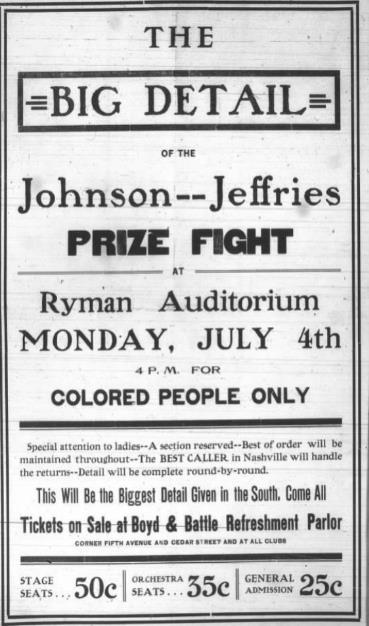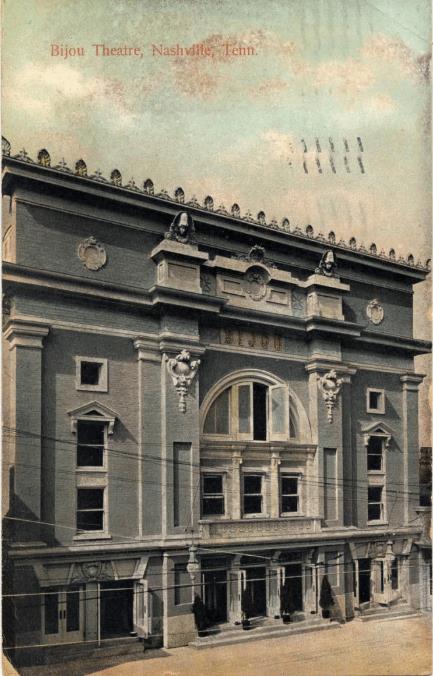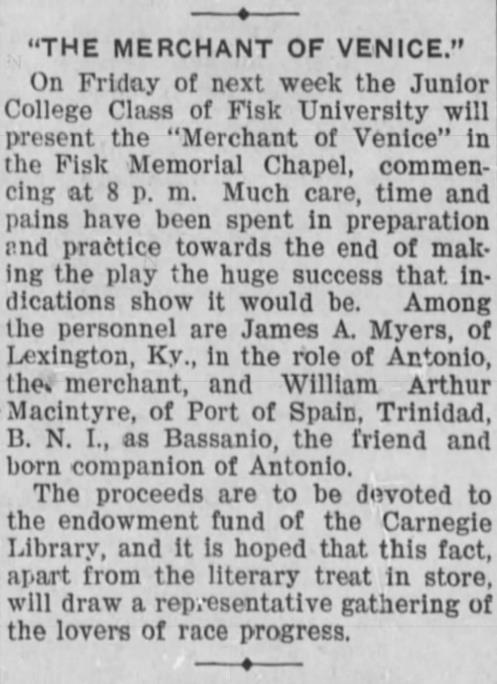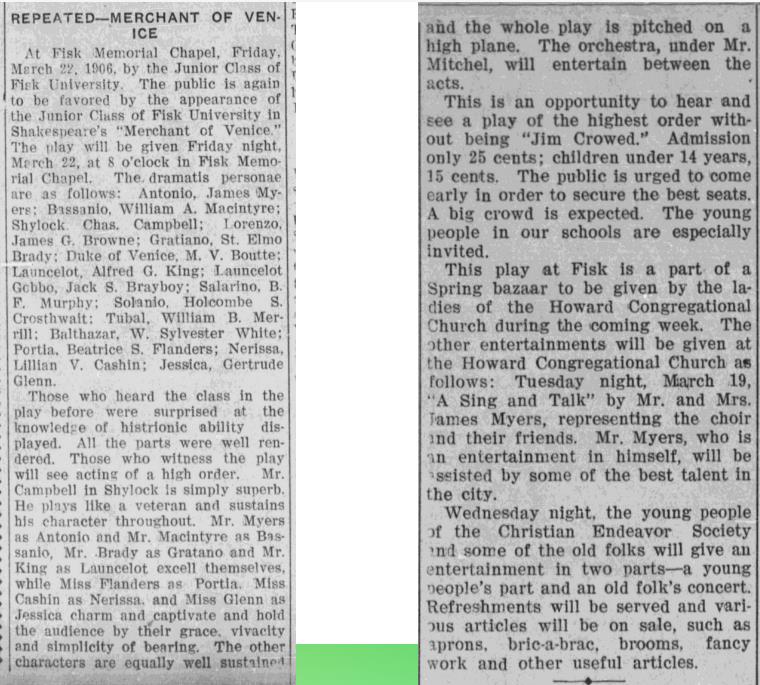In 1875, the State of Tennessee passed a law allowing anyone who owned a “place of amusement,” such as a theater, to refuse admission to “any person whom he shall for any reason whatever choose not to entertain carry or admit” (1875, House Bill 527). The law was very specific about who it excluded, including anyone “whose hair has a spiral curvature” of ¼ inch or less. The law effectively enabled theater managers to bar African-Americans from entering theaters. Read the full text of the act here. In response, newly freed African-Americans created spaces for Black art and culture to flourish in universities, churches, and community organizations. Fisk University, for instance, was founded in 1866 — just three years after the Emancipation Proclamation ended slavery in America — and quickly became a hub for the intellectual, musical, and theatrical flourishing of African-American culture in Nashville.
 During this time, predominantly white spaces would create segregated seating or advertise shows specifically for African - American audiences, such as the Ryman Auditorium’s radio broadcast of the Johnson-Jeffries fight in 1910. As reported in the project Trials, Triumphs, and Transformations
During this time, predominantly white spaces would create segregated seating or advertise shows specifically for African - American audiences, such as the Ryman Auditorium’s radio broadcast of the Johnson-Jeffries fight in 1910. As reported in the project Trials, Triumphs, and Transformations
The match between Jack Johnson, an African American, and James Jeffries, a white former heavyweight boxing champion, was hailed as "The Fight of the Century." Johnson, to the surprise of the white media, won the match handily. The advertisement . . . shows that the Ryman Auditorium was used by African Americans for a number of events during the period of segregation.
 The first professional theater for African-American audiences in Nashville, the Bijou Theatre, wasn't opened until 1916, and featured mainly films. In this context, live theater in Nashville from the close of the Civil War in 1865 until the opening of African-American theaters in 1916 was often at Historically Black Universities and Colleges in the city.
The first professional theater for African-American audiences in Nashville, the Bijou Theatre, wasn't opened until 1916, and featured mainly films. In this context, live theater in Nashville from the close of the Civil War in 1865 until the opening of African-American theaters in 1916 was often at Historically Black Universities and Colleges in the city.
 Fisk University’s production of The Merchant of Venice took place at the Memorial Chapel in 1907. Read the announcement for the production on the right. How do you think this show participated in the advancement of Black art and culture in Nashville?
Fisk University’s production of The Merchant of Venice took place at the Memorial Chapel in 1907. Read the announcement for the production on the right. How do you think this show participated in the advancement of Black art and culture in Nashville?
The play The Merchant of Venice features a Jewish moneylender named Shylock who is bullied and persecuted by Christian characters in the play. Throughout the play, Shylock seeks vengeance for the way he is treated.
In a famous speech, a Christian character, Salarino, asks Shylock why he wants revenge. Shylock responds by pointing out that Jewish and Christian people both share similar experiences. Shylock reminds Salarino that even Christians who have been hurt deeply will pursue revenge. Watch the speech below. How is Shylock asking his audience to empathize with him? How does he remind the audience of his own humanity?
Hath not a Jew eyes? Hath not a Jew hands, organs, dimensions, senses, affections, passions? Fed with the same food, hurt with the same weapons, subject to the same diseases, healed by the same means, warmed and cooled by the same winter and summer as a Christian is? If you prick us, do we not bleed? If you tickle us, do we not laugh? If you poison us, do we not die? And if you wrong us, shall we not revenge? If we are like you in the rest, we will resemble you in that. If a Jew wrong a Christian, what is his humility? Revenge. If a Christian wrong a Jew, what should his sufferance be by Christian example? Why, revenge! The villainy you teach me I will execute, and it shall go hard but I will better the instruction.
—The Merchant of Venice Act 3, Scene 1
The actor who performed Shylock was named Charles Campbell. Reviews of the production praised his performance, and especially how Campbell played Shylock in a way that invited empathy from the audience.
The character of Shylock is one that is usually held up as a model of avarice and cruelty, yet as one listened to Campbell . . . he was compelled to see as the Jew saw, and feel as the Jew felt. The audience showed its appreciation of his efforts in the stillness which pervaded the house during his speeches, and the hearty applause which followed them.
—The Nashville Globe, March 1907
How do you think the audience felt while watching Campbell? What particularly attracted them to his performance?
The play was such a hit that a revival performance was staged one month later, on March 22nd 1907. Read through the announcement of this performance in March 15th 1907 edition of the Nashville Globe on the next slide. What themes of empathy and community belonging jump out at you?

 During this time, predominantly white spaces would create segregated seating or advertise shows specifically for African - American audiences, such as the Ryman Auditorium’s radio broadcast of the Johnson-Jeffries fight in 1910. As reported in the project Trials, Triumphs, and Transformations
During this time, predominantly white spaces would create segregated seating or advertise shows specifically for African - American audiences, such as the Ryman Auditorium’s radio broadcast of the Johnson-Jeffries fight in 1910. As reported in the project Trials, Triumphs, and Transformations The first professional theater for African-American audiences in Nashville, the Bijou Theatre, wasn't opened until 1916, and featured mainly films. In this context, live theater in Nashville from the close of the Civil War in 1865 until the opening of African-American theaters in 1916 was often at Historically Black Universities and Colleges in the city.
The first professional theater for African-American audiences in Nashville, the Bijou Theatre, wasn't opened until 1916, and featured mainly films. In this context, live theater in Nashville from the close of the Civil War in 1865 until the opening of African-American theaters in 1916 was often at Historically Black Universities and Colleges in the city. 
 Fisk University’s production of The Merchant of Venice took place at the Memorial Chapel in 1907. Read the announcement for the production on the right. How do you think this show participated in the advancement of Black art and culture in Nashville?
Fisk University’s production of The Merchant of Venice took place at the Memorial Chapel in 1907. Read the announcement for the production on the right. How do you think this show participated in the advancement of Black art and culture in Nashville?